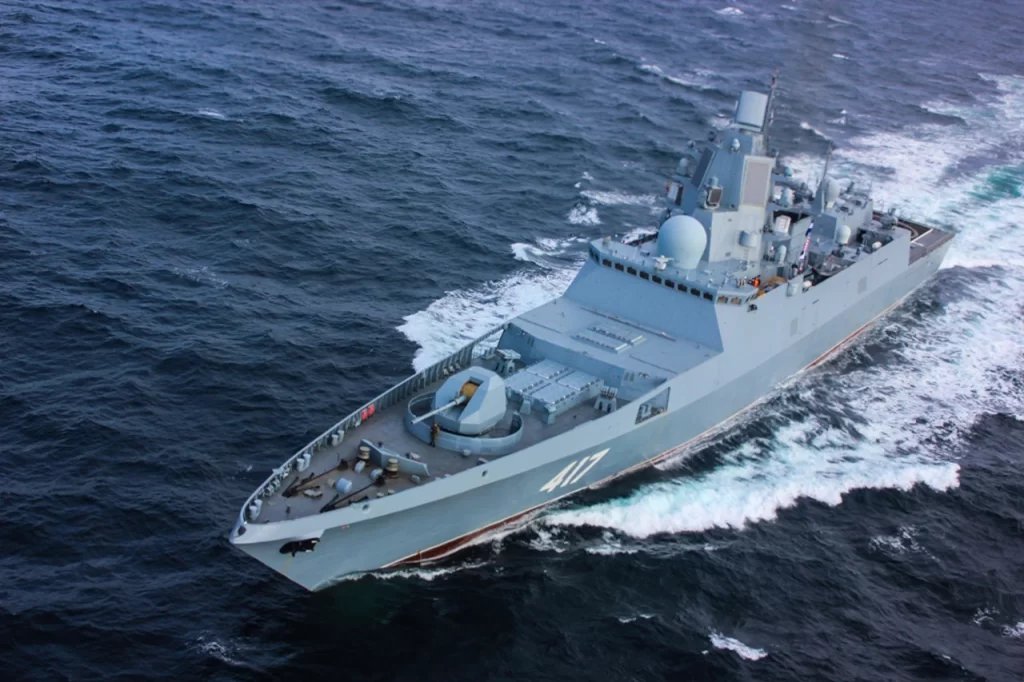The U.S. Navy has dispatched a submarine capable of carrying up to 154 Tomahawk missiles to the Persian Gulf, according to Timothy Hawkins, spokesman for the U.S. Navy’s 5th Fleet based in Bahrain.
According to a 5th Fleet spokeswoman on March 8, the nuclear-powered submarine based in Kings Bay, Georgia, passed through the Suez Canal on March 7 and was en route to the Persian Gulf. The Navy rarely divulges information about the location or disposition of submarines.
The loud announcement comes after the Russian frigate Admiral Gorshkov and the medium sea tanker “Kama” entered the port of Jeddah in the Kingdom of Saudi Arabia. It has been reported that “Admiral of the Fleet of the Soviet Union Gorshkov” is currently on a protracted journey at sea that will take it through the Atlantic and Indian Oceans and the Mediterranean Sea. Previously, Russian Navy ships made calls to Saudi Arabia ports about ten years ago, the Russian Northern Fleet press service reported. During the stay in the harbour, the vessel will replenish its fuel, fresh water and food supplies. Admiral Gorshkov is equipped with hypersonic cruise missiles called 3M22 Zirkon (spelt as 3M22 Tsirkon), the most important component of Russia’s hypersonic arsenal.
The Russian Ministry of Defense made specifically mentioned on March 5 the that the crew of the Ka-27 helicopter that was aboard the Russian frigate “Admiral of the Fleet of the Soviet Union Gorshkov” used a sonar station in the Indian Ocean while they were participating in a training exercise to look for potential enemy submarines. At the time, the ship was practising a rescue operation in the Red Sea.

Hawkins said the boat could carry up to 154 Tomahawk cruise missiles and is deployed as part of the U.S. 5th Fleet to help ensure regional maritime security and stability.
At the same time, he refused to comment on the submarine’s mission and the reasons for its redeployment to the specified area.
The 5th Fleet patrols the strategic Strait of Hormuz at the exit of the Persian Gulf, through which up to twenty per cent of the world’s crude production is transported. It is responsible for the Bab al-Mandeb Strait near Yemen and the Red Sea to the Suez Canal, which connects the Middle East and Mediterranean.
The United States and its allies employ Tomahawk, subsonic, long-range, all-weather cruise missiles. These missiles can be launched from various platforms, including submarines, ships, and aircraft, and can accurately strike targets up to 1,500 miles away. Tomahawk missiles are equipped with sophisticated guidance systems that enable them to navigate through complex terrain and avoid obstacles, allowing them to carry a variety of payloads, including conventional or nuclear warheads. The Tomahawk missile’s low-altitude flight and covert capabilities make it difficult to detect and intercept, giving it a significant combat advantage. The Tomahawk missile has established its worth in conflicts such as the Gulf War and Operation Iraqi Freedom, making it a valuable addition to the U.S. military’s arsenal.
Comparatively, 3M22 Tsirkon missiles can attain speeds of up to Mach 9, or nine times the speed of sound. This makes them exceedingly difficult to intercept, as they are faster than any currently existing anti-missile system. Zircon missiles can be launched from multiple platforms, including submarines, ships, and aircraft, and have a range of over 1,000 kilometres.
Since the Trump administration withdrew from a 2015 agreement between Iran and a coalition of Western powers providing sanctions relief in exchange for Iran curbing its nuclear activities and establishing increased monitoring of Iran’s nuclear facilities, tensions have risen sharply between the U.S. and Iran.
The efforts of the administration of President Joe Biden to revive the agreement failed last year, but tensions have increased since Iran transferred its attack drones to Russia for use in its war with Ukraine.
Tehran also seeks to improve ties with China, which facilitated an agreement to restore diplomatic ties between Iran and Saudi Arabia last month.
In light of the delivery of Iranian drones and other equipment to the Russian Federation, the U.S. administration is concerned and is carefully examining the most recent reports regarding a potential expansion of cooperation between Iran and Russia, including in cyberspace.
During the first quarter of 2023, the administration concentrated on tackling Islamic Republic security challenges. In February, CENTCOM commander Gen. Michael “Erik” Kurilla warned that Tehran’s military capabilities had developed significantly, becoming more technologically advanced and formidable than only five years previously. Similarly, Secretary of Defense Lloyd Austin claimed in March that Iran was the principal source of Middle Eastern instability. In reaction to the March attacks on U.S. outposts in Syria by Iranian-backed forces, President Biden emphasised that the U.S. had no intention of inciting confrontation with Iran but vowed to take immediate action to protect its people.
